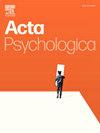The relationship between restrained eating and exercise addiction: The chain mediating role of social physique anxiety and grit
IF 2.7
4区 心理学
Q2 PSYCHOLOGY, EXPERIMENTAL
引用次数: 0
Abstract
Background
Exercise addiction often coexists with eating disorders and extreme dietary habits. It has remained unclear whether restrained eating, the most common maladaptive behavior in eating disorders, is associated with exercise addiction and whether some common psychological factors will affect their relationship. This study aimed to explore the interplay among restrained eating, exercise addiction, social physique anxiety, and grit.
Methods
A cross-sectional study was conducted with 1575 Chinese college students (73.9 % men) aged 17–24 (19.68 ± 0.02). Data were collected using the Dutch Eating Behavior Questionnaire, the Exercise Addiction Inventory, the Social Physique Anxiety Scale, and the Grit Scale. Structural equation modeling (SEM) was used to test the hypothesized chain mediation model linking restrained eating, social physique anxiety, grit, and exercise addiction. Group differences were assessed using ANOVA and multi-group SEM across different types of restrained eaters.
Results
The results indicated that restrained eating, social physique anxiety, grit and exercise addiction were significantly correlated. Notably, social physique anxiety and grit exhibited a chain mediation effect on the relationship between restrained eating and exercise addiction. Likewise, significant group differences were observed among failed restrained eaters, successful restrained eaters, and non-restrained eaters in exercise addiction (F = 21.018, p < 0.01), social physique anxiety (F = 151.464, p < 0.01), and grit (F = 12.303, p < 0.01). Social physique anxiety and grit still had a partial chain mediating effect on the relationship between restrained eating and exercise addiction across the three different restrained eating groups.
Conclusions
These findings highlight that prioritizing the identification of different types of restrained eaters, alleviating social physique anxiety, and curbing untimely grit can serve as effective strategies to prevent exercise addiction.
节制饮食与运动成瘾的关系:社交体质焦虑和毅力的连锁中介作用
运动成瘾通常与饮食失调和极端的饮食习惯共存。节制饮食是饮食失调中最常见的适应不良行为,但它是否与运动成瘾有关,以及是否有一些常见的心理因素会影响两者的关系,目前还不清楚。本研究旨在探讨克制饮食、运动成瘾、社交体质焦虑和毅力之间的相互作用。方法对1575名17-24岁的中国大学生(19.68±0.02)进行横断面研究,其中男性占73.9%。数据是通过荷兰饮食行为问卷、运动成瘾量表、社会体质焦虑量表和毅力量表收集的。采用结构方程模型(SEM)对自制饮食、社交体质焦虑、毅力和运动成瘾之间的链式中介模型进行检验。使用方差分析和多组扫描电镜对不同类型的克制进食者进行组间差异评估。结果克制饮食、社交体质焦虑、毅力和运动成瘾呈显著相关。社交体质焦虑和毅力在克制饮食与运动成瘾的关系中表现出连锁中介效应。同样,在运动成瘾(F = 21.018, p < 0.01)、社交体质焦虑(F = 151.464, p < 0.01)和毅力(F = 12.303, p < 0.01)方面,克制失败者、克制成功者和非克制者的组间差异显著。社会体质焦虑和毅力在三个不同的克制饮食组中对克制饮食与运动成瘾的关系仍有部分链式中介作用。结论优先识别不同类型的克制型进食者,减轻社交体质焦虑,抑制不合时宜的毅力是预防运动成瘾的有效策略。
本文章由计算机程序翻译,如有差异,请以英文原文为准。
求助全文
约1分钟内获得全文
求助全文
来源期刊

Acta Psychologica
PSYCHOLOGY, EXPERIMENTAL-
CiteScore
3.00
自引率
5.60%
发文量
274
审稿时长
36 weeks
期刊介绍:
Acta Psychologica publishes original articles and extended reviews on selected books in any area of experimental psychology. The focus of the Journal is on empirical studies and evaluative review articles that increase the theoretical understanding of human capabilities.
 求助内容:
求助内容: 应助结果提醒方式:
应助结果提醒方式:


